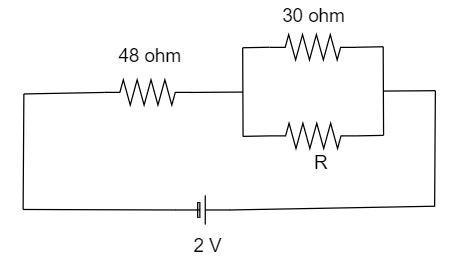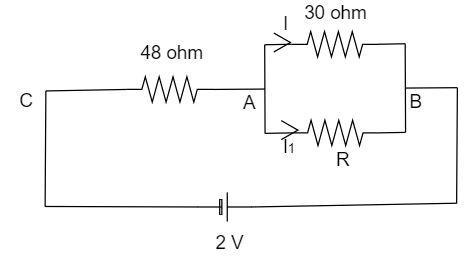
In the circuit shown, when $R$ is removed an additional resistance of $72\,$ ohm must be introduced in series with the battery in order to keep the current through $30\,$ ohm resistance unaltered. Hence $R$ is

Answer
216.6k+ views
Hint From the given circuit diagram, calculate the current, potential difference and the total current across each branch. Apply the formula below and substitute the calculated values to find the resistance of the resistor that is removed from the circuit.
Useful formula
The formula of the ohm’s law is given by
$V = IR$
Where $V$ is the potential difference, $I$ is the current flowing through the circuit and $R$ is the resistance.
Complete step by step solution
It is given that the
Resistor $R$ is removed from the circuit.
The additional resistor that must be connected to main the current, $72\,\Omega $

The value of the resistor, $R' = 30\,\Omega $
current $ = \dfrac{2}{{28 + 30 + 72}} = \dfrac{1}{{75}}\,A$
Voltage across $CA = $ Total voltage - voltage across $AB$
${V_{CA}} = 2 - \dfrac{2}{5} = \dfrac{8}{5}\,V$
Total current $ = \dfrac{8}{{5 \times 48}} = \dfrac{1}{{30}}\,A$
Since the resistor is connected in parallel, the potential difference developed across each resistor will be the same. Hence
$V = V'$
By substituting the ohms law in the above step,
$I'R = I\left( {30} \right)$
Rearranging the obtained equation, we get
$I' = \dfrac{{30I}}{R}$
Substituting the value of the resistance in the above equation, we get
$I' = \dfrac{{30}}{{75R}} = \dfrac{2}{{5R}}$
It is known that in a parallel circuit, the total current flows in the circuit will be equal to the sum of the currents flows in the individual branch.
$I = I + I'$
Substituting the values of the current in it,
$\dfrac{1}{{30}} = \dfrac{1}{{75}} + \dfrac{2}{{5R}}$
By simplify g the above equation by performing carious basic arithmetic operations,
$\dfrac{2}{{5R}} = \dfrac{1}{{50}}$
By further simplification of the above equation
$R = 20\,\Omega $
Hence the value of the resistance is obtained as $20\,\Omega $ .
Note
Remember that in a parallel circuit, the current flowing through the circuit will be the sum of the current flowing through each resistor and the voltage developed across each resistor will be the same. Hence the voltage across one resistor must be the subtraction of the other voltage with the total.
Useful formula
The formula of the ohm’s law is given by
$V = IR$
Where $V$ is the potential difference, $I$ is the current flowing through the circuit and $R$ is the resistance.
Complete step by step solution
It is given that the
Resistor $R$ is removed from the circuit.
The additional resistor that must be connected to main the current, $72\,\Omega $

The value of the resistor, $R' = 30\,\Omega $
current $ = \dfrac{2}{{28 + 30 + 72}} = \dfrac{1}{{75}}\,A$
Voltage across $CA = $ Total voltage - voltage across $AB$
${V_{CA}} = 2 - \dfrac{2}{5} = \dfrac{8}{5}\,V$
Total current $ = \dfrac{8}{{5 \times 48}} = \dfrac{1}{{30}}\,A$
Since the resistor is connected in parallel, the potential difference developed across each resistor will be the same. Hence
$V = V'$
By substituting the ohms law in the above step,
$I'R = I\left( {30} \right)$
Rearranging the obtained equation, we get
$I' = \dfrac{{30I}}{R}$
Substituting the value of the resistance in the above equation, we get
$I' = \dfrac{{30}}{{75R}} = \dfrac{2}{{5R}}$
It is known that in a parallel circuit, the total current flows in the circuit will be equal to the sum of the currents flows in the individual branch.
$I = I + I'$
Substituting the values of the current in it,
$\dfrac{1}{{30}} = \dfrac{1}{{75}} + \dfrac{2}{{5R}}$
By simplify g the above equation by performing carious basic arithmetic operations,
$\dfrac{2}{{5R}} = \dfrac{1}{{50}}$
By further simplification of the above equation
$R = 20\,\Omega $
Hence the value of the resistance is obtained as $20\,\Omega $ .
Note
Remember that in a parallel circuit, the current flowing through the circuit will be the sum of the current flowing through each resistor and the voltage developed across each resistor will be the same. Hence the voltage across one resistor must be the subtraction of the other voltage with the total.
Recently Updated Pages
Wheatstone Bridge Explained: Working, Formula & Uses

Young’s Double Slit Experiment Derivation Explained

JEE Atomic Structure and Chemical Bonding important Concepts and Tips

JEE Amino Acids and Peptides Important Concepts and Tips for Exam Preparation

Electricity and Magnetism Explained: Key Concepts & Applications

Chemical Properties of Hydrogen - Important Concepts for JEE Exam Preparation

Trending doubts
JEE Main 2026: Application Form Open, Exam Dates, Syllabus, Eligibility & Question Papers

Derivation of Equation of Trajectory Explained for Students

Hybridisation in Chemistry – Concept, Types & Applications

Understanding the Angle of Deviation in a Prism

Understanding Collisions: Types and Examples for Students

How to Convert a Galvanometer into an Ammeter or Voltmeter

Other Pages
JEE Advanced Marks vs Ranks 2025: Understanding Category-wise Qualifying Marks and Previous Year Cut-offs

Understanding Atomic Structure for Beginners

Ideal and Non-Ideal Solutions Explained for Class 12 Chemistry

Degree of Dissociation: Meaning, Formula, Calculation & Uses

Understanding Electromagnetic Waves and Their Importance

Understanding the Electric Field of a Uniformly Charged Ring




